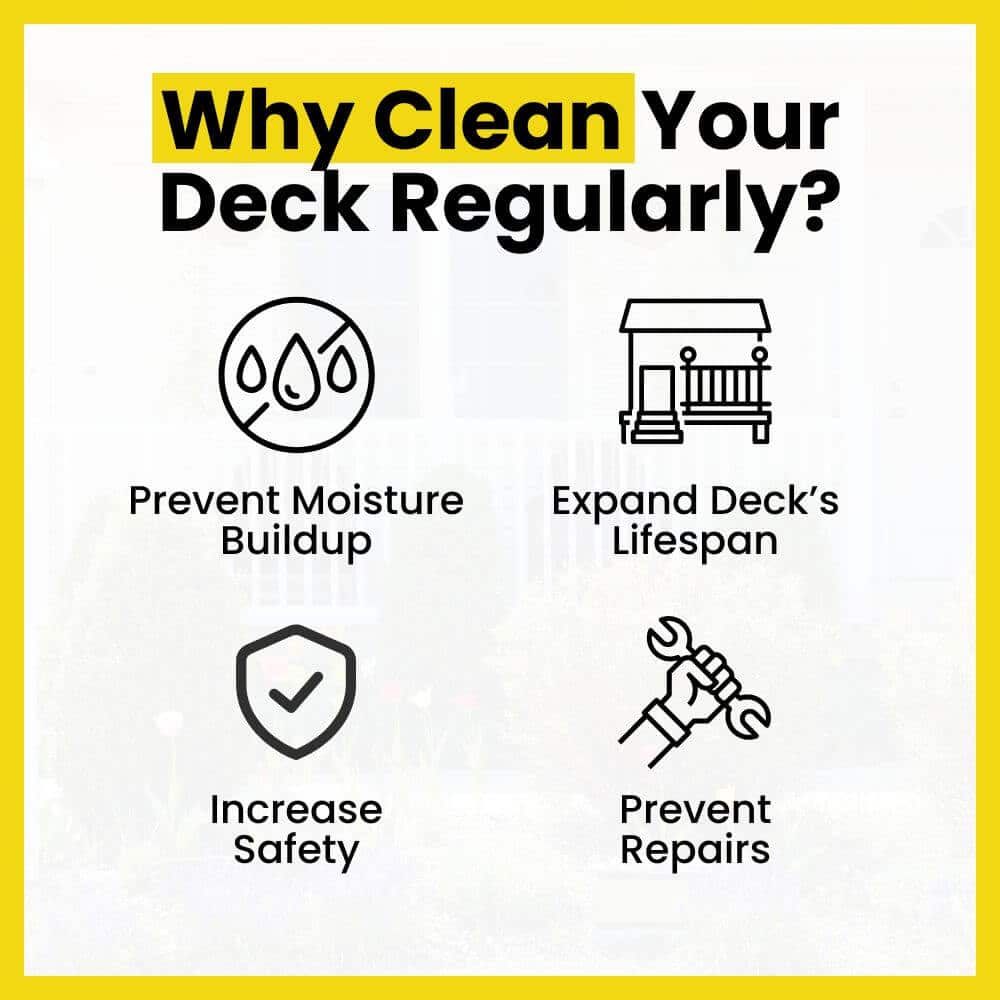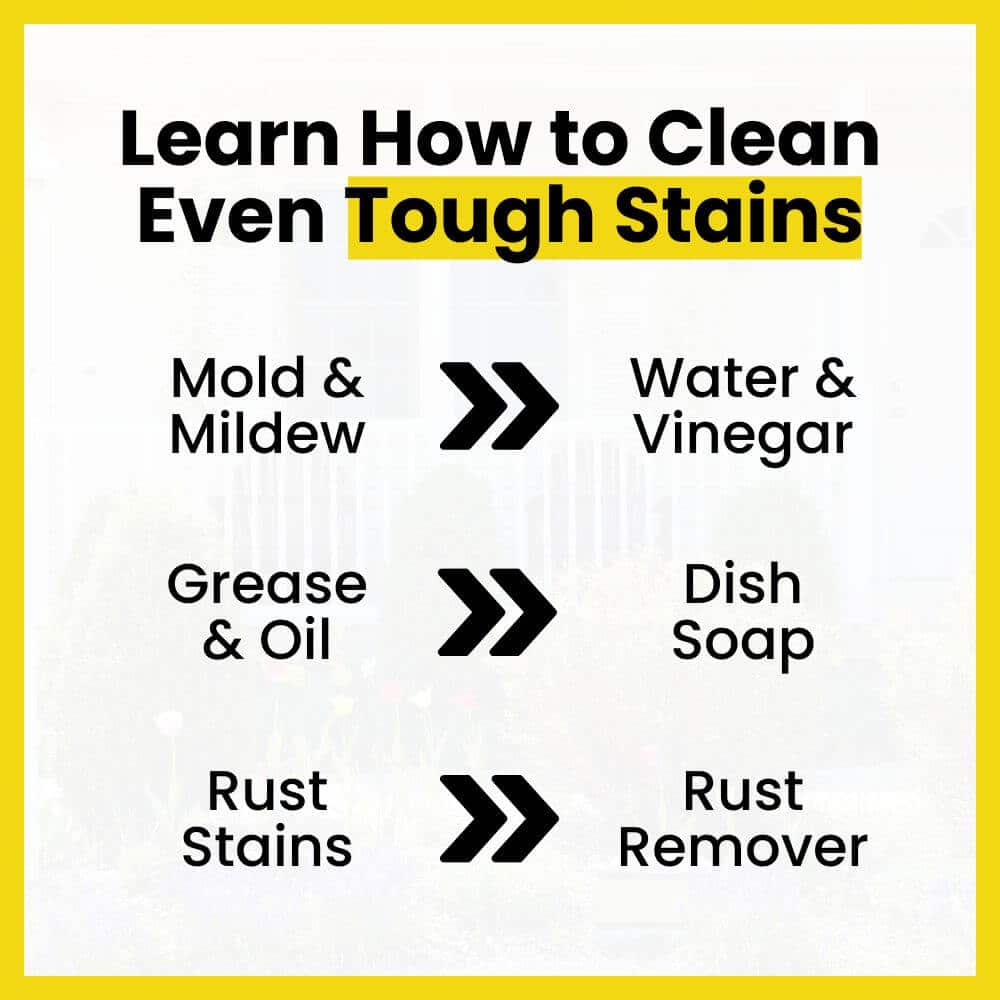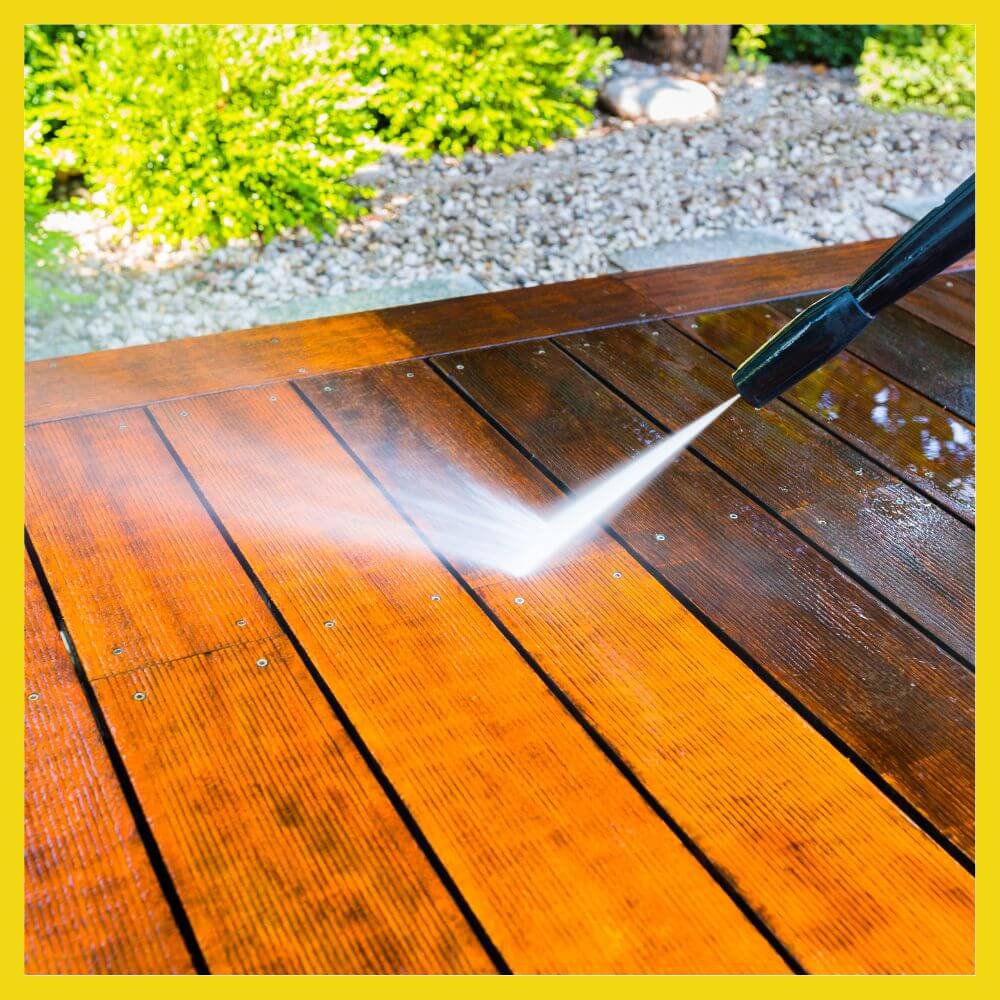Your deck serves as a beautiful extension of your living space, perfect for summer barbecues and relaxing evenings under the stars.
However, without proper maintenance, decks can quickly become worn, dirty, and even hazardous. Regular cleaning is essential to preserve the beauty and integrity of your wooden deck, ensuring it remains a safe and inviting space for years to come.
In this comprehensive guide, we’ll walk you through everything you need to know about cleaning a wood deck effectively. From basic techniques to tackling tough stains and slippery surfaces, we’ll share expert tips and tricks to help you achieve results without causing harm to the wood.
Looking to breathe new life into your deck? Or maybe you’ve got your eye on a brand new build? Contact us to learn more about how we build stunning, custom decks for homeowners just like you.
When Should You Clean Your Wooden Deck?
Cleaning your wooden deck is a crucial aspect of its maintenance regimen, but determining the right time to clean it can sometimes be a bit tricky.
Several factors come into play when deciding when to tackle this task, including seasonal changes, weather conditions, and the level of foot traffic your deck receives.
Here’s a closer look at when you should clean your wooden deck to keep it looking its best year-round.
Seasonal Considerations
Keeping your deck clean year-round helps preserve it for years to come. Here are some techniques for maintaining your deck before summer hits and in preparation for winter.
Spring Cleaning
Spring is an ideal time to give your wooden deck a thorough cleaning after the winter months. During winter, your deck may have accumulated debris, such as leaves, dirt, and branches, which can lead to mold and mildew growth if left unattended.
Cleaning your deck in spring helps remove winter grime and prepares it for the warmer months ahead.
Fall Maintenance
Fall is another opportune time to clean your wooden deck, especially if you live in an area with heavy foliage.
As leaves begin to fall, they can accumulate on your deck and trap moisture, creating a breeding ground for mold and mildew. Regular cleaning in the fall helps prevent these issues and prepares your deck for winter weather.
Weather Conditions
Cleaning your deck during the right weather helps ensures your efforts have maximum impact. Here are a few factors to consider.
Dry Weather
It’s best to clean your wooden deck when the weather is dry and mild.
Wet conditions can make the cleaning process more challenging and prolong the drying time, potentially leading to mold and mildew growth.
Aim to clean your deck on a sunny day with temperatures between 50°F and 70°F for optimal results.
Extreme Temperatures
Extreme temperatures, whether hot or cold, can affect the efficacy of cleaning solutions and potentially damage the wood.
Avoid cleaning your deck during heat waves or freezing temperatures, as these conditions can compromise the integrity of the wood and make it more susceptible to damage.
Foot Traffic and Usage
How often you clean your deck depends on your level of use and any special occasions you’re preparing for.
High Foot Traffic Areas
If your deck receives heavy foot traffic, such as during parties or gatherings, it may require more frequent cleaning to remove dirt, spills, and other debris.
Regular sweeping and spot cleaning can help prevent dirt buildup and prolong the time between deep cleanings.
Before Special Events
If you’re hosting a special event or celebration on your deck, consider thoroughly cleaning beforehand to ensure it looks its best for your guests.
A clean, well-maintained deck sets the stage for an enjoyable outdoor gathering and enhances the overall ambiance of your outdoor space.
Why Should You Clean Your Wood Deck Regularly?

There are several reasons to clean your wooden decking regularly:
-
- Removing debris and contaminants prevents moisture buildup.
- Proper cleaning and maintenance extend the lifespan of the deck
- Regular deck cleaning removes slippery mold, mildew, and algae, reducing the risk of slips and falls.
Regular cleaning prevents the need for extensive repairs or replacement
Preparing for Deck Cleaning
Before you begin cleaning your wood deck, it’s essential to gather the necessary supplies and prepare the area to ensure a successful outcome. Here’s what you’ll need:
-
- Broom or leaf blower
- Garden hose or pressure washer
- Deck cleaner or homemade cleaning solution
- Scrub brush or deck scrubber
- Protective gear (gloves, goggles, mask)
- Stiff bristle brush for tough stains (optional)
- Stain or sealant (if planning to stain the deck afterward)
Once you have your supplies assembled, clear the deck of any furniture, plants, or other objects.
Sweep away debris using a broom or leaf blower, paying special attention to corners, cracks, and crevices where dirt tends to accumulate.
Trim back any overhanging vegetation that may obstruct the cleaning process or contribute to moisture buildup on the deck surface.
Basic Wooden Deck Cleaning Techniques
When it comes to cleaning a wood deck, there are several methods you can use, depending on the level of dirt and grime present. Here are some basic cleaning techniques to consider:
Cleaning with Water and Mild Detergent
For routine cleaning or lightly soiled decks, a simple solution of water and mild detergent can be highly effective.
Mix warm water with a small amount of dish soap or mild detergent in a bucket. Using a scrub brush or deck scrubber, apply the solution to the deck surface, working in small sections.
Scrub the wood gently, paying attention to areas with visible stains or discoloration. Once you’ve cleaned the entire deck, rinse thoroughly with a garden hose or pressure washer to remove soap residue and loosened dirt.
Allow the deck to dry completely before replacing furniture or applying any treatments.
Using a Pressure Washer to Clean Your Deck
Cleaning your wooden deck with a pressure washer can be an efficient way to remove dirt, grime, and other contaminants, restoring its appearance and prolonging its lifespan.
However, it’s essential to use the pressure washer correctly to avoid damaging the wood. Follow these step-by-step instructions to safely and effectively clean your wooden deck using a pressure washer:
Step 1: Prepare the Area
Before you begin, clear the deck of any furniture, plants, or other objects. Trim back overhanging vegetation to prevent damage to the wood and ensure unobstructed access to the entire deck surface.
Cover nearby plants, shrubs, and landscaping with plastic sheeting or tarps to protect them from overspray and runoff.
Step 2: Sweep and Inspect the Deck
Use a broom or leaf blower to remove debris, leaves, and loose dirt from the deck surface. Inspect the deck for any loose or protruding nails, screws, or boards that may pose a safety hazard or interfere with the cleaning process.
Make any necessary repairs before proceeding to ensure a smooth and even cleaning surface.
Step 3: Select the Right Nozzle and Pressure Setting
Choose a wide-angle nozzle (such as a 25- or 40-degree nozzle) for cleaning wooden decks, as narrower nozzles can be too intense and may damage the wood.
Adjust the pressure washer to a low to medium pressure setting, typically between 1500 and 2000 PSI (pounds per square inch), to avoid gouging or splintering the wood.
Test the pressure washer on a small, inconspicuous area of the deck to ensure it’s not too powerful.
Step 4: Wet the Deck Surface
Before using the pressure washer, thoroughly wet the deck surface with water using a garden hose. This will loosen any buildup and allow your cleaning solution to work its magic.
Start at one end of the deck and work your way across, ensuring the entire surface is evenly saturated.
Step 5: Pressure Wash the Deck
Hold the pressure washer nozzle at a consistent distance from the deck surface, typically 6 to 12 inches away, and at a slight angle to the wood grain.
Begin cleaning at one end of the deck and work your way toward the opposite end, overlapping each pass slightly to ensure thorough coverage. Move the nozzle in smooth, sweeping motions, following the direction of the wood grain to avoid causing damage.
Step 6: Rinse Thoroughly
Once you’ve cleaned the entire deck, thoroughly rinse away any remaining detergent, dirt, and debris using the pressure washer.
Start at the highest point of the deck and work your way downward, ensuring all surfaces are rinsed clean. Pay particular attention to corners, edges, and crevices where dirt may accumulate.
Step 7: Allow the Deck to Dry
After rinsing, allow the deck to dry completely before replacing furniture or applying any sealants or finishes.
Depending on the weather conditions and the type of wood, this may take several hours to a full day. Avoid walking on the deck until it’s completely dry to prevent slips and falls.
Step 8: Inspect Your deck
Once the deck is dry, inspect the surface for any remaining stains, spots, or damage. If necessary, spot-clean any stubborn stains or areas that may have been missed during the initial cleaning.
Cleaning Tough Stains and Problem Areas on Your Wooden Deck

Even with regular maintenance, wood decks can develop tough stains and problem areas that require special attention. Here are some common issues and strategies for addressing them:
Cleaning Mold and Mildew
Mold and mildew thrive in damp, shaded areas, making them common problems on wood decks. To remove mold and mildew, use a commercial deck cleaner specifically formulated for this purpose.
Alternatively, you can create a homemade cleaning solution using equal parts water and white vinegar or oxygen bleach. (Spot-check a small area to make sure the solution doesn’t harm the finish on your deck.)
Apply the cleaner to the affected areas and scrub gently with a brush or scrub pad. Rinse thoroughly with water and allow the deck to dry completely.
To prevent mold and mildew growth in the future, ensure adequate ventilation and sunlight exposure.
Cleaning Stains from Food, Grease, or Oil
Food spills, grease splatters, and oil leaks can leave unsightly stains on your wood deck.
To remove these stains, start by blotting up any excess liquid with a clean cloth or paper towel. Then, apply a grease-fighting dish soap or specialized deck cleaner to the affected area and scrub gently with a brush.
If the stain persists, you may need to use a commercial deck brightener or wood stain remover to lift the discoloration.
Follow the manufacturer’s instructions carefully and rinse thoroughly after treatment.
Cleaning Rust Stains on the Wooden Deck
Metal furniture, planters, or hardware can sometimes leave rust stains on a wood deck.
To remove these stains, use a rust remover specifically designed for use on wood surfaces. Apply the rust remover according to the manufacturer’s instructions, taking care to protect surrounding vegetation and surfaces.
After allowing the remover to work, scrub the stained area gently with a brush or scrub pad. Rinse thoroughly with water to remove any remaining residue.
Cleaning Your Deck without Chemicals
If you prefer to avoid harsh chemicals or are concerned about their impact on the environment, there are several eco-friendly alternatives you can use to clean your wood deck. Here are a few options to consider:
Cleaning Your Deck with Vinegar
White vinegar is a versatile and eco-friendly cleaning agent that can be used to clean a variety of surfaces, including wood decks. To clean your deck with vinegar:
-
- Mix equal parts white vinegar and water in a spray bottle.
- Spray the solution onto the deck surface and allow it to sit for a few minutes to loosen dirt and grime.
- Scrub the wood gently with a stiff-bristled brush or scrub pad, then rinse thoroughly with water.
Steam Cleaning Your Deck
Steam cleaning is another eco-friendly option for cleaning a wood deck without the use of chemicals. A steam cleaner uses hot water vapor to penetrate and lift dirt, grease, and stains from the surface of the wood.
To steam clean your deck, use a steam cleaner with a wide nozzle attachment and work in small sections, moving the nozzle along the wood grain.
Be sure to follow the manufacturer’s instructions and take care not to hold the nozzle in one spot for too long, as excessive heat can damage the wood.
Power Washing Your Wooden Deck

Power washing is a highly effective method for deep cleaning your deck, removing stubborn dirt, mildew, and weather stains. This method uses a high-pressure water spray to clean deeper than standard washing methods.
To begin, select a pressure washer suitable for your deck’s material. Use a lower pressure setting for soft woods to prevent damage. Attach a wide nozzle, typically 40 to 60 degrees, to distribute the water pressure evenly and avoid gouging the wood.
Before starting, clear the deck of all furniture and sweep off loose debris. Cover sensitive areas like plants and windows to protect them from the high-pressure spray. If your deck is very dirty, consider applying a deck-cleaning solution to break down tough grime before rinsing.
Start washing from the house outward, maintaining a consistent distance of 6 to 12 inches from the deck surface. Move the nozzle in a sweeping motion parallel to the wood grain to ensure thorough cleaning without leaving marks.
After washing, rinse the deck with clean water to remove any soap or remaining debris. Allow the deck to dry completely, which typically takes about 48 hours, before replacing furniture or applying any treatments like stains or sealants.
How to Clean a Composite Deck
Cleaning a composite deck is almost the same as cleaning a wooden deck but since composite decks are more vulnerable to scratches and scuffs, use a soft brush or a non-abrasive pad for cleaning.
Maintaining your composite deck doesn’t have to be a chore. With a little regular upkeep, you can enjoy a beautiful deck year-round.
In addition to regular cleaning, be sure to sweep your deck regularly to remove dirt, leaves, and other debris. Trim back any overhanging vegetation to prevent mold and mildew growth, and inspect the deck periodically for any signs of damage or wear.
Ready to Take Your Deck to the Next Level?
A clean, well-maintained wood deck can be a source of pride and enjoyment, providing a beautiful and functional outdoor space for relaxation and entertainment. By following the tips and techniques outlined in this guide, you can keep your wood deck looking its best for years to come.
Want to update your deck? Need a new deck? At Perimeter Remodeling, we have over 20 years of experience building dream decks for homeowners just like you.
To learn more about a new deck or an upgrade to your existing deck, contact us for a free estimate today!



Recent Comments